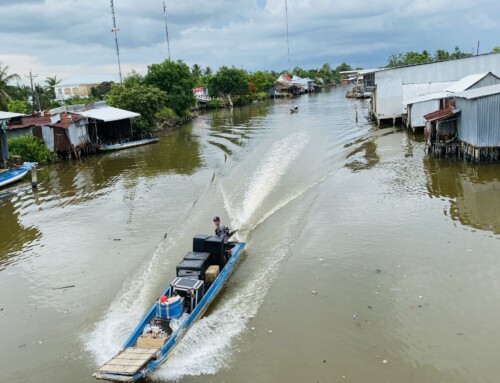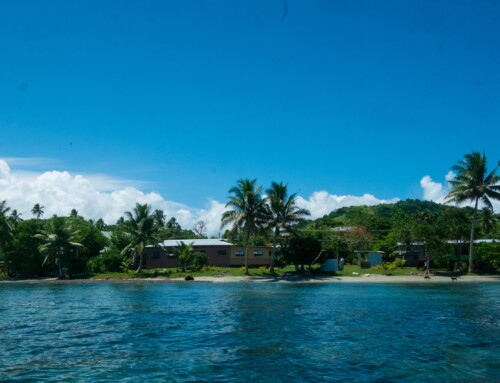The Sekong, Sesan and Sre Pok basins are richly endowed with natural resources and support the livelihoods of an estimated 3.5 million people living in Cambodia, Lao PDR and Vietnam. In early-March, potential trade-offs among development decisions in the 3S basins, and their social, economic and environmental risks were the topic of a dialogue involving government representatives of the Lower Mekong Basin (LMB) countries and technical experts from regional organisations.
The two-day event was the launch of the project, Measuring, Understanding and Adapting to Nexus trade-offs in the 3S River Basins, followed by the first meeting of the 3S Nexus Regional Technical Advisory Group (TAG). The project forms part of the Lower Mekong Initiative (LMI) Nexus Futures Programme, and aims to improve the quality of planning and investment in the 3S region.
The “nexus” refers to the closely bound interaction between water, energy and food production and use. The vision is coordinated planning, development, optimization and operation of portfolios of water infrastructure for benefits across sectors and, in the case of the 3S basins, across international boundaries.
“The LMI has created a platform to share best practices for more than seven years and during this time, the intersection between water, energy and food clearly became an issue of common concern for all parties,” said Jason McInerney, Unit Chief for Environment, Science, Technology and Health for the Embassy of United Stated of America (a partner and funder of the LMI) at the event opening.
In the 3S region, the nexus dialogue is led by IUCN, as part of the Building River Dialogue and Governance (BRIDGE) programme, which supports the capacities of countries sharing river or lake basins to implement effective water management arrangements. “As the Asian region develops, the 3S Rivers will continue to play a significant role in the economic growth of the basin,” said Jake Brunner, head of IUCN Indo-Burma. “The benefits of long-term transboundary water conservations significantly exceeds the short-term benefits of unilateral project based development,” he said.
Co-funded by BRIDGE, the nexus assessment is being conducted by ICEM – International Center for Environmental Management and International Water Management Institute (IWMI) in partnership with IUCN. The launch and TAG meeting relates to stream 1 of the project, which involves conducting a nexus assessment guided by the TAG. “The nexus assessment is integral to, and will underpin the rest of the work that needs to take place,” said Brunner. Once completed, the nexus assessment will be followed by the integration of the assessment outcomes with key national and regional planning processes (stream 2) and finally, utilizing the nexus assessment outcomes and principles to enhance the diplomatic and economic regional dialogue (stream 3).
The launch workshop served to introduce the project to senior government staff and TAG members from Cambodia, Lao PDR and Vietnam. The nexus, and how it can contribute to decision making and Integrated Water Resources Management (IWRM) was explained and an introduction to the nexus assessment and water-energy-food trade-offs in river basin development was presented. According to IWMI Theme Leader for Ecosystem Services, Dr Matthew McCartney, key issues include increasing demand and pressure on water due to population growth, climate change, industrialization and more demand on water resources. “It is widely accepted that solutions to resource degradation and trade-offs between uses will require planning and managing the 3S basins in an integrated manner across sectors and across international borders.” He said that the idea of the nexus assessment is to try and identify inter-connections and synergies, and possible win-win strategies. “As the development process goes forward, we also have to think about what we want to keep in the 3S basins for future generations,” said ICEM Director General and Team Leader for stream 1, Dr Jeremy Carew-Reid. “How is the current development pathways that we are taking reinforcing those values or undermining them?”

Participants at the launch of the project, Measuring, Understanding and Adapting to Nexus trade-offs in the 3S River Basins.
A strategic element of the nexus assessment is the TAG. The expert group will be closely involved in the design and delivery of the project. “We need to take advantage of your experience and expertise in shaping the nexus assessment and the final product,” said Brunner to the TAG members present.
A large part of the two-day event was dedicated to sessions where country representatives shared their knowledge and ideas in a series of presentations on the major drivers of change in water use in the 3S basins, the possible impacts for people and the environment, and the extent to which win-win outcomes can be achieved in competing water uses. Also, group discussions were held on initiatives in place to address management challenges, knowledge gaps that need to be filled, where the nexus project fits institutionally, and how it can best influence decision makers.
In conclusion, Brenner said that the project will not solve all the problems of the 3S but it can show that another future is possible – with benefits for all countries and stakeholders. “We are limited by budget and time, and will not be able to answer all the problems and questions, but by harnessing our resources and knowledge we can demonstrate best practice when it comes to river basin management in the 3S.”
The workshop and TAG meeting was the first of three that will take place in early 2017 for the purpose of the nexus assessment (stream 1). The project completion date (streams 1 – 3) is set for 2018.








Leave A Comment